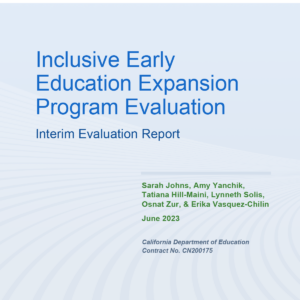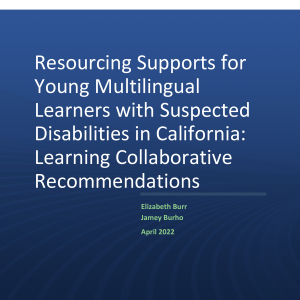Expanding Access to Inclusive Early Education for Children With Disabilities
Posted on

By Sarah Johns
Inclusive education settings provide crucial social-emotional and academic foundations that support positive outcomes for all students and help all students better understand and celebrate differences. Despite the positive benefits, however, inclusive early education program options are rare, limiting access for many families of children with disabilities.
During the 2022–23 school year, fewer than half of U.S. preschoolers with disabilities protected under the Individuals With Disabilities Education Act received their special education supports and services within inclusive early education programs.
Policymakers and state leaders need successful implementation models to guide their efforts in addressing this gap. This blog post covers strategies to expand access to inclusive early education for children with disabilities. The strategies are based on findings from WestEd’s evaluation of the California Department of Education’s Inclusive Early Education Expansion Program (IEEEP). The evaluation included surveys and focus groups, visits to inclusive early education programs, and reviews of documents, seeking perspectives on expansion efforts from district and county offices of education staff, collaborative community agencies, early education program leaders, educators, and families of children with and without disabilities.
To expand access to inclusive early education programs for children with disabilities, IEEEP grants between 2020 and 2024 provided funding to 65 school districts and county offices of education throughout California.
Families value inclusive early education
As part of the IEEEP evaluation, over 2,000 families of children enrolled in inclusive early education programs throughout California participated in a survey, and 100 families participated in a focus group.
Three out of four families of children with and without disabilities reported that being in an inclusive early childhood program had a positive impact on their children.
Some described how their children with disabilities made improvements in language and social-emotional skills.
I definitely have seen the improvements in his interactions with people, and even with the play dates we do after school with other families and other kids. I’ve seen an improvement, especially with his speech and his socialization. So it’s been a great benefit so far.
—Family member of a child with disabilities
Similarly, families of children without disabilities described how children learned to play with each other and appreciate individual differences.
It’s a bonus for our kids to be able to see all different walks of life, all different learning techniques or teaching techniques. Because for certain kids, one thing might work; for other kids, that might not work so well. So for them to be exposed to different learning techniques, I think that’s really beneficial.
—Family member of a child without disabilities
Partnerships between general and special education are critical to inclusive early education
Successful inclusion in early education hinges on effective collaboration between general and special education teams. Local processes, such as regular meetings and planning sessions, can foster teamwork and enhance communication among families, educators, and specialists, helping ensure that all children have access to high-quality, inclusive learning environments.
The Early Childhood Technical Assistance Center, funded by the U.S. Department of Education’s Office of Special Education Programs, recommends collaborative staffing structures for inclusive early education programs. However, the IEEEP evaluation revealed that local education agencies need targeted assistance to implement these staffing structures.
IEEEP grantees reported increased collaboration between general and special education teams. Yet, survey results showed there was room for improvement: Although 90 percent of program leaders reported having inclusive classrooms, less than 40 percent had special education staff available to co-teach, consult, or provide services for children.
Diverse community partnerships can expand access to inclusive early education
When schools and community organizations work together, they can increase the availability of inclusive early education, professional development opportunities for educators, and valuable resources and expertise. These collaborations also enhance family engagement, ensuring that programs meet the needs of all children and families.
IEEEP grantees used their funding to build a variety of partnerships, including with
- other school districts and county offices of education,
- state-funded early education programs,
- Head Start,
- special education and local early intervention providers, and
- local child care leadership entities such as resource and referral agencies or quality rating and improvement systems.
In focus groups and surveys, over 200 grantees and collaborative community agencies described how funding for collaboration allowed for co-learning around inclusion, understanding systemic barriers to inclusion, promoting consistent implementation, improving communication between special education providers and families, and expanding access to inclusive early education for children with disabilities.
Because of the grant, we now have much better partnerships with local agencies running state preschools and Head Starts, so more students are being included, there is a shared commitment to increase and expand inclusion moving forward, and conversations about blending programs occur regularly and the work will continue.
—Partner collaboration survey respondent
Grantees and collaborative community agencies reported several key strategies that helped enhance access to inclusive early education programs for children with a broad range of disabilities. These strategies helped increase individualized supports for families of children with disabilities, helped create more inclusive early education systems in local communities, and helped support teachers in inclusive early education programs.
- Making sustainable systems improvements that support inclusion, such as:
-
- Developing or streamlining procedures for identifying and referring children with developmental concerns, partnering to provide specialized services for children with disabilities in inclusive early education settings, and prioritizing inclusion in discussions about the child’s least restrictive environment for learning.
- Working with partners to develop a shared vision for inclusion, a common definition, and/or a shared measurement plan.
- Restructuring staffing in early education programs so that special education staff are more available to support early childhood general education teachers and children with disabilities in inclusive early education settings.
- Creating new resources that support inclusion, such as:
-
- Creating and offering professional development on inclusion and/or curating lending libraries for adaptive and specialized equipment to support children’s participation in learning and play activities.
- Creating newsletters, social media, online resources, and parent resource guides to increase community awareness about early childhood inclusion.
- Developing and executing memoranda of understanding (MOUs) with partners to increase enrollment of children with disabilities in inclusive early education programs by:
-
- Setting aside enrollment slots for children with disabilities in inclusive early education programs.
- Using MOUs to share information and data and to increase the amount and type of special education services for children with disabilities.
- Collecting or using data to:
-
- Continuously improve access to inclusive early education efforts for children with disabilities.
- Identify and respond to early education programs’ facilities, adaptive equipment, and professional development needs around inclusion.
Key investments improve early education staff’s inclusion knowledge, confidence, and practices that support children with disabilities
The IEEEP evaluation findings revealed three key investments that helped grantees expand access to inclusive early education programs: professional development for early educators, facility construction or renovation, and adaptive equipment purchases.
The majority of the 1,000 early education leaders and teachers who responded to an online survey reported that the professional development they completed on inclusion had an impact on their awareness of the benefits of inclusion, their knowledge of inclusive practices, and their ability to implement inclusive practices. In focus groups, nearly 100 grantees, early education leaders, and teachers described how professional development helped build their capacity, increased their openness, and reduced their hesitation to implement inclusive early education.
Improvements to early education facilities expanded local capacity for inclusion by increasing existing facilities’ compliance with Americans With Disabilities Act standards for accessibility and by building additional classrooms, expanding or developing early education programs, or establishing designated spaces for children to receive special education services.
Grantees supported early education programs to purchase and use adaptive equipment, including offering environment consultations, creating and distributing kits of adaptive materials, and creating new professional development programs on how to use adaptive equipment to support individual children’s participation in learning and play activities. In focus groups, early education leaders and teachers described how this helped them support individual children’s needs, make learning more accessible to all children, and use inclusive instructional strategies.
Data infrastructure is needed so communities can monitor equitable access to inclusive early childhood education programs
Data infrastructure helps communities monitor equitable access to inclusive early childhood education programs, enabling states to track which children are receiving services, to identify gaps in access, and to ensure the allocation of resources to areas of greatest need. However, the IEEEP evaluation found that many local communities lacked adequate data systems to monitor and evaluate inclusive education efforts effectively.
In the evaluation, WestEd analyzed enrollment trends for children with disabilities using two different data sources. State administrative data, collected through a standardized data system, showed an increase in enrollment in the state preschool program. Grantee-reported data revealed inconsistent enrollment trends due to fragmented data collection systems across different educational sectors and partners. The lack of local data made it difficult to draw conclusions about how enrollment of children with disabilities increased beyond state-funded early education programs.
Sustaining inclusive programs requires a comprehensive systems approach funded through federal, state, and local resources
Although the evaluation of the IEEEP found that most state-funded early education programs implemented inclusive models of early education and increased enrollment of children with disabilities during the grant period, the sustainability of these programs remains a significant concern.
Sustained investments in inclusive early education are needed for both individual early education programs and for the building blocks that support inclusive early childhood education systems. These include collaboration between general and special education entities, data infrastructure and sharing, professional development for early educators, facility construction and improvements, adaptive equipment purchases, and increasing community awareness of inclusion.
Strengthening these elements will help local communities expand access to and sustain inclusive early childhood education settings as well as better support educators and families in helping children with disabilities thrive.

Dr. Sarah Johns is a Senior Research Associate. Her work at WestEd includes evaluations of the Inclusive Early Care and Education Expansion Program funded through the California Department of Education and the Fresno Cradle-to-Career portfolio of investments designed to reduce racial and ethnic disparities in maternal and child health outcomes, early care and education access, and family economic well-being.


